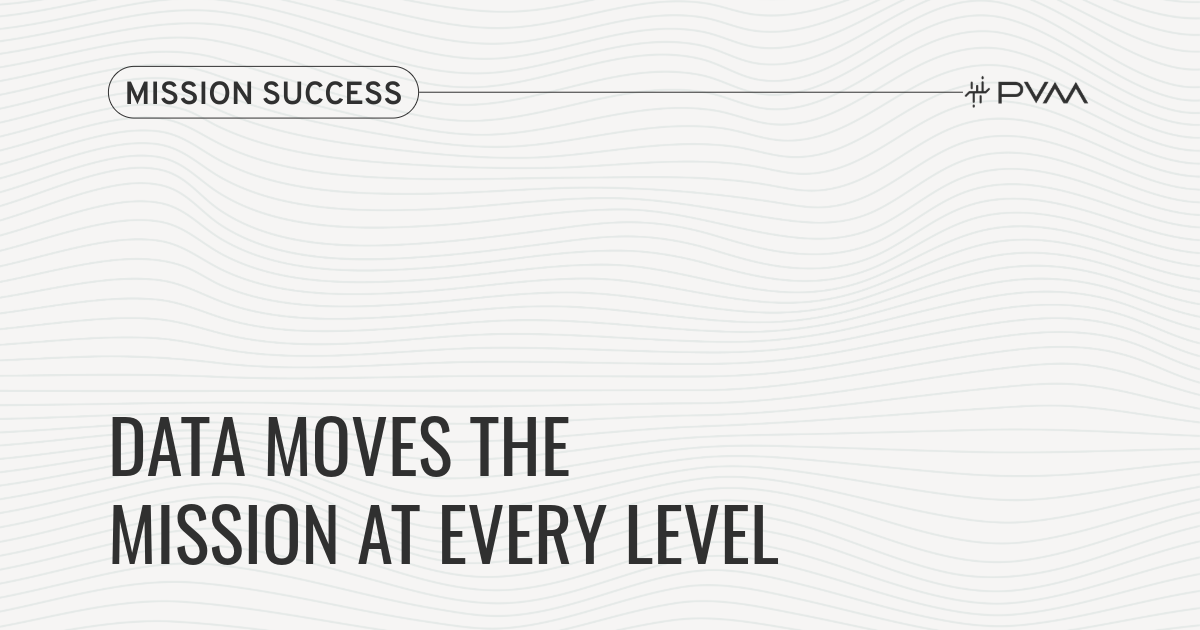Meet Terrence Alexander: Former CDC Fellow and Current PVM Data Scientist
We sat down with Terrence Alexander, Data Scientist at PVM. His path from Memphis to the CDC — and now to PVM — reflects a career built on curiosity,...
I NEED HELP WITH...
I'M WORKING WITH...
INDUSTRIES

At PVM, we have extensive experience unlocking the power of data and helping our clients achieve their missions in federal, state, and local governments, as well as commercial sectors. In today's data-driven world, organizations across all sectors recognize that their success hinges on harnessing the full potential of their data.

ABOUT US
TECH PARTNERS


The story of one such client challenge and what we learned from it.
Anyone who has ever performed a workforce transition process for a client knows that the ability to both prepare in advance and tackle unforeseen challenges is vital.
It can be a lot like remodeling your home: You draw up the plans, you make sure they’re up to code, you assemble the materials, you get a quote and a timeline for the labor. Then, one of your key contractors has a family emergency that puts him out of commission for two weeks. Or there’s a local ordinance that prevents you from building within so many feet of protected wildlife, and you need to deal with the red tape. Or there’s a problem with your wiring you didn’t know about before that will need to be solved. Or—at time of writing, early summer 2021, many will painfully relate to this—there’s a historic lumber shortage.
The more complicated an undertaking, the more work is required before starting and the more room there is for things to potentially go wrong along the way. And workforce transition is decidedly a very complicated process.
Our best advice:
Just a few short years ago, PVM was approached by a financial services client to gauge whether PVM’s IT service capabilities were a good fit to aid in their mission. They were looking to transition their entire workforce for a certain platform to a new vendor, and they needed a a third party to help them do it. They chose us.
The client was a global company with thousands of employees, hundreds of thousands of customers, and terabytes of critically important real-time data. This team had been supporting this client for many years. This was an unprecedented transition event between the partner and the next vendor to support them.
We wanted more than anything to ensure success of this transition. Therefore, the transition occurred over a period of six months and was managed closely by all members of the PVM support staff, project manager, and our CEO. This kind of communication between all important parties is key to generating an effective transition plan.
The first three months were a fairly standard transition step for this kind of client: “vendor on-boarding.” This stage required us, as a company, to pass through various compliance, security, human resources, and operational checks before any of our personnel could start working on the contract. The Director of Operations met weekly with the client’s Vice President of the program to ensure all vendor checkpoints were met and barriers to doing so, removed. For example, the client required PVM to establish a new background check account and manage all background checks for transitioning personnel.
We cannot stress this enough: Security is no joke. It is critical that any firm that takes on a project like this take that step with every ounce of seriousness that it deserves.
Once we had passed the major blockers in vendor on-boarding, we began working to develop a transition-in plan with the client to include personnel on-boarding, background checks, system and data access, knowledge transfer, and phased-approach to fully transitioning the technical and project efforts with our workforce.
Here's an increasingly common issue with staff augmentation: location, location, location. This client wanted at least half of the team on-site and at their location, which was nearly a thousand miles away from our office in Southern California. Luckily, industry solutions to this issue are also increasingly common: We leveraged our strategic recruiting agency partner who had experience sourcing candidates nationwide.
In short: we had the labor, the materials, and the designs, and we were ready to remodel.
The Transition-In plan from contract start lasted for three months. This is when the challenges arose.
For instance, the amount of knowledge transfer depended on the access level of our resources. We assigned transition leads for our technical resources to ensure knowledge transfer was as efficient as possible. One hurdle down.
We also underestimated the technical debt we were about to inherit. This can be rather an unpleasant surprise for an IT firm, although far from an uncommon one.
To solve this, our Director of Technology met one-on-one with both the partner and the client’s technical leads to very helpfully shed light on the technical debt and suggest ways forward. Never underestimate the value of your client’s or partner’s guidance! Workforce transition is a team effort, and everyone wants the same thing.
PVM overcame these challenges and received exemplary remarks from the client. We continue to provide exceptional IT staff to support their mission, delighting them to the point we recently received a 4.5 out of 5 client satisfaction rating, and our number of staff and technical services footprint have more than doubled since we first transitioned.
So what did we learn? This workforce transition proved to be something of a trial-by-fire for the PVM team; both our ability to formulate meticulous plans ahead of time, and our ability to improvise solutions to unforeseen hurdles, turned out to be essential skill sets in how we navigated the process.
Everyone knows that when you remodel your home, the journey can wind up being circuitous. That’s why it’s so important to have the skill sets to tackle the unplanned. What doesn’t get talked about enough is when it’s done: the paint is fresh, the furniture is in place, and you can finally sit comfortably and enjoy your beautiful, new, quintessentially you space. Each challenge turned out to be an opportunity to further customize the home you really wanted. When you think back on the work that went into creating it, what you feel is no longer the frustration or anxiety of whether it will work out; what you feel is victory.
This comfortable feeling, a feeling of home, a sense of accomplishment, a feeling that is unique to you and totally customized to your needs—that’s the feeling that PVM strives for in facing all our challenges.

We sat down with Terrence Alexander, Data Scientist at PVM. His path from Memphis to the CDC — and now to PVM — reflects a career built on curiosity,...

By Sydney Metzmaker Data can move the mission — and when it does, it’s one of the most powerful forces in government operations. When data flows...

By Bret Frederick When I was a young Marine, I worked as a systems administrator on the Marine Corp’s air battle planning system. It was part of a...